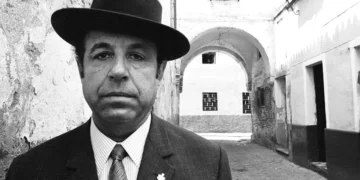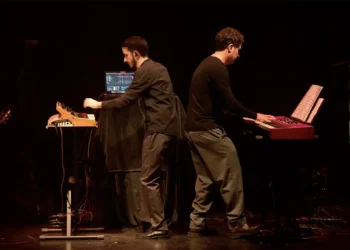|
| Daily coverage BIENAL DE FLAMENCO sponsored by: |
Dance: Antonio Canales. Guitar: Daniel Méndez, Paco Iglesias.
Cante:
Herminia Borja, Guadiana, Potito. Percussion: Lucky Losada, Isidro
Suárez.
Chorus: Remedios Silva, Aroa Pisa.
The night of Friday at the Maestranza Antonio Canales presented
his show as part of the expanded program of the Bienal added at
the last minute, and the disappointing level seemed to reveal the
need to put something together hurriedly with fingers crossed behind
backs hoping no one would notice. But we did notice. Despite Canales
still being the genius he’s always been, a lone dancer cannot
hold up an entire show on his own (one hour and twenty minutes),
even less so with a ho-hum back-up made up of three “nayno”
girls, competent but underused singers and guitarists, and a cajón
that longed to be the star of the night.
With a touch of arrogance the program informs us we are about to
witness “a journey to the purest sort of flamenco”.
Who writes this stuff? The repertoire sounded interesting enough,
no question about it: martinete, seguiriya, bulerías, tangos,
bulerías, soleá, and fin de fiesta, but the reality
had little to do with the expected impact. Like all God’s
children, Canales is aging – he’s visibly short of breath
and the effect of his most inspired moments, which continue to abound,
is correspondingly diminished. One misses Juan de Juan – or
Pepe de Pepe or Paco de Paco, anyone at all to offer a respite from
the image of Canales in that oddly rumpled suit, doing footwork
and hyperventilating beneath the implacable spotlight which forgives
nothing.
 |
 |
Unable to find that sublime madness
that characterizes his artistic personality
The footwork solo which opens the show (there’s a bit of
cante just to say we did, but it’s a footwork solo no matter
how you slice it), is too dense and lengthy for an opening number.
In this dance, as throughout the entire show, the cajón,
with that annoying added rim-shot sound is far too dominant. A cante
solo with Guadiana and Potito whose respective styles and voice
are mutually compatible in the most Camaronic sense, feels like
extra baggage. Tangos sung by Herminia Borja, the individual who
most approaches a state of grace, adorns a bit of dance, and a loooong
percussion solo with the stage in blackness fails to provoke the
thundering applause it seems to be begging for. A guitar solo with
female chorus and you start wondering what ever became of Canales.
The star returns to dance por soleá with the guitars producing
those dark rich sounds that come from tuning down a string or two,
one of the best ideas the new generation has come up with, but once
again the singers remain nearly idle and the footwork solo descends
upon us all. Six of one, half a dozen of the other, it’s just
more of the same. The night begins with a low to middling level
and never goes any further, The final bulerías momentarily
heats up but the bottom line is Canales didn’t get it right
this time, nor was he able to find that sublime madness that characterizes
his artistic personality.
Text : Estela
Zatania
Photos: Manny Rocca
“Festival”
Dance: Milagros Mengíbar; Cante: Juan Reina y Manolo
Sevilla; Toque: Rafael
Rodríguez. Cante: la Macanita; Guitar: Manuel Parrilla; Palmas:
Chícharo and
Gregorio. Cante: Calixto Sánchez; Guitar: Manolo Franco.
Cante: Fernando
Terremoto; Toque: Antonio Higuero; Palmas: Chícharo y Gregorio.
The same stage that yesterday saw Juana Amaya evoke Carmen
Amaya, today received a show which celebrated the relationship between
Sevilla and Jerez. Dancer Milagros Mengíbar, and singers
Macanita, Calixto Sánchez and Fernando Terremoto took over
the Lope de Vega theater. In two and a half hours of flamenco dance
and song there’s time for everything, but also time for tiring
of sitting immobilized in a theater seat. When will we be fortunate
enough to see a show or recital that lasts less than an hour and
a half and leaves us wishing for more? Another thing entirely is
the performer who just takes the money and runs. This was definitely
not the case of tonight’s artists whose performances were
entirely respectable.
Milagros danced a caña after Fernando Terremoto’s
appearance with the Cádiz people. The long train know as
a “bata de cola” which almost seems an extension of
her body, paints undulating silhouettes. She moves the dress with
elegance and command in a such a way that it’s no obstacle
whatsoever for her dance. On the contrary…the beauty of her
fluid movements rests in the majesty of how she handles the bata.
Standard-bearer of grace and coherence, the woman from Seville pays
tribute to her hometown with her entire body offering a style that
is diametrically opposed to the current norm. Her dance is rich
in subtle gestures, she seeks expression through her hands, with
the twisting of her torso and impeccable compás. A few days
ago Matilde Coral remarked that people used to dance to cante. That
is exactly what Milagros does, she delights at the sound of an “ay!”
or a flourish of the guitar and demonstrates it’s not necessary
to overdo with footwork, time is at her service and she allows herself
the artistic license of an understated closing to the sound of lively
compás. She knows how to stand still and how to fill an entire
stage with a mere glance.
Macanita sings her voice raw with no guitar accompaniment in the
opening martinete “la huerta de Molina”. Sounds of Alcalá
and Utrera conform the soleá por bulería. The style
and the voice which don’t quite come together tonight are
reminiscent of Fernanda de Utrera who is never far away when Macanita
sings soleá. She’s even more at home with bulerías.
With “El corazón tras la puerta” the compás
squad appears: Chícharo, Gregorio and Macano, a sure guarantee,
and all that’s left is the ‘fin de fiesta’.
Calixto Sánchez has a completely different repertoire to
offer: malagueña, tientos, milonga and alegrías. The
singer from Mairena knows how to deliver the cante and he is orthodox
to a fault, always “correct”. He delves into the past
to revive styles and verses but also resorts to famous poets setting
Alberti’s poems to alegrías. One could argue he lacks
emotion, but the quality of his interpretation and his desire to
give his all are attributes well-received by the audience which
awarded him a standing ovation, the only artist of the night so
honored. Manolo Franco’s guitar brought “oles”
and applause, and his musical rapport with Calixto was superb.
Fernando Terremoto launches his round voice to warm up for bulería
por soleá. Malagueña is dressed with melisma and phrasing,
but the most striking quality is the emotional undercurrent. Seguiriyas,
the round “aaay” that proclaims pain and causes the
silence to listen. He fits and links the verses well and reigns
in at just the right moment. He finishes off with bulerías
and sings a few things away from the mike to show off his impressive
lungpower.
The Bienal is getting better and better.
Text: Kiko
Valle
|
|
Related products:
|
|























